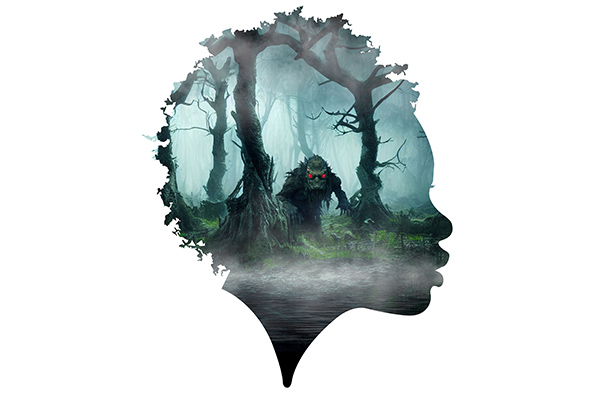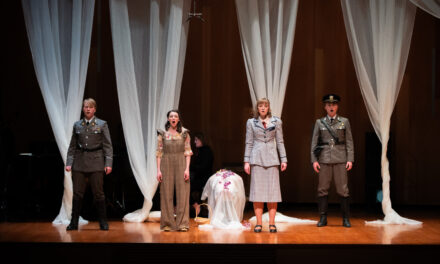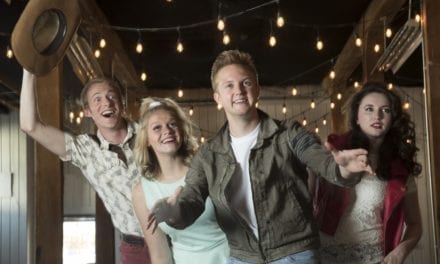OGDEN — The first words I heard as I took my seat at the Eccles Theatre at Weber State University’s Browning Center for the Performing Arts were, ““Ooh! Are those your fireflies?”. The black box theatre had been organized to have the audience in a traverse stage setup with the stage space in the middle. The fireflies were tiny slowly blinking Christmas lights woven into tresses covered in an array of green materials worthy of Mother Nature herself. Lighting designer Kace Bartholome, whose fireflies I appreciated, sat behind me and pointed out that the set up of the stage, with levels of forest greenery and a playground of logs, bogs and stumps for the actors to roam on was intended to appear like a terrarium with the audience as spectators on the outside.
The effect was tremendous. Immediately, I felt the implication of watching helplessly from the sidelines in the world premiere of Dan Caffrey’s The Amphibians. The play is billed as being in the near future as, “two high school students unearth a discovery in the woods and must learn hard lessons about the evolution of friendship and what it means to take care of something at the end of the world.” Much of the play centers on two students — Simone and Bryn, seeking taking care of a massive unknown species but finding their efforts to be increasingly futile, and even unnecessary. This effect of watching close up but not being able to help was a stunning design choice by Porter Lance, and profoundly successful. I would want Lance to design sets for me, and it’s the kind of design I wish I could show to others as an example of high level creative staging. Each of the technical aspects shone at this level, and my brief chat with Barthlome informed me of the clear vision the design team had for the production.

The world premiere of Dan Caffrey’s The Amphibians plays at Weber State University through March 2, 2024
The staging had a Brechtian quality to it where it was impossible to ignore the reality that this was a play, and a somewhat absurd one at that. Belief is never fully suspended. The play is set in dystopian 2037 Central Florida as teenage Gen Z high schoolers romp in the woods and share the discovery of an unknown creature that is maneuvered with great vitality by puppeteers Jaron Shereda and Cooper Hartman. I don’t think it is too much of a spoil to reveal that the creature that Bryn and Simone, played by Bee Higgins and Tessa Eagar respectively, find in the woods turns out to be amphibious.
Much like Brecht’s Waiting for Godot, the play has little driving it forward other than the imminent arrival of something. In Brecht’s case it is Godot and in Caffrey’s it is the rising of sea levels that will flood the forest and surrounding areas. Beyond this, the play hints at the challenged relationships Simone has with her drug addled mother, and Bryn, but doesn’t go much further. As someone whose full time work is with teenagers, the script did little to give Higgins or Eager meaningful teenage personalities. Bryn is level-headed, caring, and has grown distant from Simone as Bryn has become a cheerleader, and thinks through her future goals and plans. Simone, by contrast, is a rebel without a cause. She uses profanity with abandon, resents her mom, and won’t listen when Bryn points out that there are serious flaws in her plan to take care of the creature they’ve discovered. Simone both resents Bryn, is indifferent to her concerns, and takes incredible umbridge with anything Bryn does. She claims to care about the world ending, but litters aggressively. In some ways The Amphibians is, as Shakespeare says, full of sound and fury; signifying nothing. I think that is intentional — to make the audience ponder the need to not be idle bystanders as they are in the world of the play, but it is aggravating to watch nonetheless.
Director Lily Hilden does an excellent job helping Higgins, Eager, and the puppeteers to utilize the space. While the scenes collectively don’t drive a compelling narrative, the actors were able to utilize every bit of the stage in the telling of their story. As scenes pass, the actors leave more and more clutter and litter in the natural appearing space, and the choice to do so flagrantly again points to the invitation for the audience to consider the world they are creating. In the pre-show announcements, it was announced that the materials for the show were all from found, reused or repurposed materials and that carbon emissions offsets had been purchased to create as little waste as possible from the production.

Photos: David Daniels
The strongest performances were from Shereda and Hartman as the puppeteers. For over an hour, in tandem, the pair controlled a large puppet that breathed, ate, and displayed a variety of emotions. The puppeteers were involved with their full bodies. As a puppet head would move, so would actor heads. The breathing was synchronized, and the intensity of the eyes from the performers communicated clearly the intents of the beast. They were aided by Isaac Dunlap’s strong vocal work. He utilized a bright green balloon and a microphone to create reptilian, or more accurately amphibian, noises as well as a host of other soundscape effects.
Higgins and Eager had the difficulty of playing teenagers while being not much older than teenagers. I don’t think they were aided in the writing of those characters, but neither actor had clear objectives. At times they seemed to play down the intelligence and emotional development of the characters. Bryn cared about Simone and the creature, but not in a way that moves the story forward. Higgins found the empathetic notes of Bryn’s character, and found ways to physically embody the emotionally inarticulate nature of the character. Eager had a greater challenge with Simone. Simone has challenges that are pitiable, but they are underdeveloped in the script. Eager navigated the barely suppressed pain of the character, often masked in crude humor, but was again not given a grounded and well rounded character to work with. Eager sometimes overplays the character’s aggression and doesn’t have anywhere to build to, but that aggression is also the character’s ultimate downfall in the end.
The production did so many things so well. It was beautiful, practical, and thought provoking. Weber State University has utilized a talented student population to highlight a fascinating new work that pushes audiences to consider if they are bystanders in the ecology of the earth. Like the terrarium style scenic design, this is a play worth watching. It seems to be watching back.





